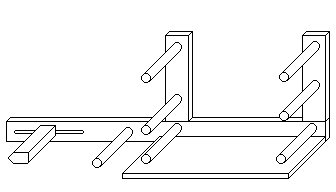|
|
 
 
When purchasing an inkle loom, be sure to select one that
is made of a hard wood. Inkle looms are under stress during
their use and the softer woods will distort under those pressures
over time. Look for smooth sanding of the pegs to avoid snagging
the warp. Pegs that have been coated with a modern finish
such as polyurethane, are very nice to use. Check the tensioning
device for heavy duty hardware. The bolt used in the tensioning
device is also under a great deal of pressure. Be sure to
pay the extra money for the higher quality loom. Keep these
things in mind too if you choose to construct your own loom.
Plans for inkle looms can be found in books on weaving in
the library. Check the index of weaving books. Many will
have a chapter or part of a chapter on inkle and card (or
tablet) weaving. Another thing to consider when purchasing
an inkle loom is how long of a strip you will be able to
weave on it. This is determined by the path that the warp
threads will take when you warp the loom. The finished length
will be shorter than the actual warp path due to two things.
One is that you cannot weave the entire length. It's impossible.
When the beginning part of the weaving reaches the top front
peg, the weaving must stop because the warp straddles that
bar. The other reason you cannot weave the full original
warped length is due to an effect know as take-up.
When the warp threads travel over and under the weft threads,
this effectively shortens the path of the band. That is why
the tensioning bar is part of the loom. You make the adjustments
as the band shortens. Take-up is greater as the diameter
of the weft increases. Most manufacturers will indicate the
approximate maximum length of band that the loom will produce.
 Inkle looms come in a variety of sizes but there are two
basic size categories of inkle looms. The smaller ones are
known as table looms (some are small enough to be called "lap
looms") and are the most common ones that you may see
at SCA events. These ones generally will weave bands 90 to
110 inches in length, depending on the number of pegs and
the height and length of the loom. To be able to weave greater
lengths, you need to consider a floor loom. The design concept
is basically the same as the table model. It is just larger.
Another way to get much longer lengths, but on a table-sized
loom, is to obtain one of the newer looms that will take
a non-continuous length of warp. It accomplishes this via
the same technique employed in a fabric loom with the warp
ends tied and wrapped at the back of the loom on a warp beam
and then wrapped onto a cloth beam in the front as the weaving
progresses. |